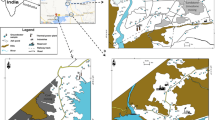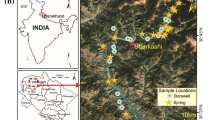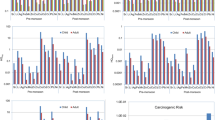Abstract
The present investigation explores the spatial and seasonal variations in potentially toxic element (PTEs) concentrations and contamination level assessment of groundwater samples in and around the Asansol industrial city, eastern India. The representative samples of groundwater from 24 different locations were analyzed for pH, electrical conductivity (EC), total dissolved solids (TDS), total hardness (TH) and PTEs, e.g., Pb, Cu, Cd, Zn, Fe and Cr for pre-monsoon and post-monsoon. The pH level of examined groundwater samples is under the desirable limit with few exceptions (S5, S11 and S16 in pre-monsoon and S12 in post-monsoon). The recorded values for Pb, Cd, Fe and Cr in many sampling stations found higher than the prescribed limits of Indian standards (IS 10500: 2012) in both the seasons. The mean contamination factor (Cf) for PTEs in the groundwater is in the order of Cr > Fe > Cd > Pb > Cu > Zn and Fe > Cr > Cd > Pb > Cu > Zn, with mean contamination index (Cd) value of 2.83 and 2.72 in pre-monsoon and post-monsoon season, respectively, indicating moderate level of contamination in the examined area. Geospatial depiction of HPI values shows high level of contamination during pre-monsoon (58.3% sampling sites) and post-monsoon (45.8% sampling sites) in majority of sampling sites. Further, application of multivariate statistical analysis ascertains that the PTEs in groundwater are majorly derived from anthropogenic activities such as opencast mining, thermal power plants, iron and steel industries, sponge iron and other metallurgical industries, and leachate from urban and industrial wastes along with limited contribution from geogenic and lithogenic sources. The health risk assessment demonstrates that the non-carcinogenic risk (due to PTEs) in adults is in the sequence of Cr > Cd > Pb > Fe > Cu > Zn, while for children the order is Cr > Pb > Cd > Fe > Cu > Zn for both the seasons. The results also reveal higher chance of occurrence of carcinogenic risk due to Cr (ILCR > 1.0E-04) for children and adults in both the seasons.










Similar content being viewed by others
References
Adhikari, K., Sadhu, K., Chakroborty, B., & Gangopadhyay, A. (2013). Effect of mining on geochemistry of groundwater in Permo-carboniferous Gondwana coalfields: Raniganj Basin, India. Journal of the Geological Society of India, 82, 392–402.
Ahamad, A., Raju, N. J., Madhav, S., & Khan, A. H. (2020). Trace elements contamination in groundwater and associated human health risk in the industrial region of southern Sonbhadra, Uttar Pradesh, India. Environmental Geochemistry and Health, 42(10), 3373–3391.
Al-Khashman, O. A. (2008). Assessment of the spring water quality in The Shoubak area, Jordan. The Environmentalist, 28, 203–215.
Al-Khashman, O. A., & Jaradat, A. Q. (2014). Assessment of groundwater quality and its suitability for drinking and agricultural uses in arid environment. Stochastic Environmental Research and Risk Assessment, 28, 743–753.
American Public Health Association (APHA). (1998). Standard methods for the examination of water and wastewater (22nd ed.). American Public Health Association.
Backman, B., Bodis, D., Lahermo, P., Rajpant, S., & Tarvainen, T. (1997). Application of ground water contamination index in Finland and Slovakia. Environmental Geology, 36, 55–64.
Banerjee, U. S., & Gupta, S. (2013). Impact of industrial waste effluents on river Damodar adjacent to Durgapur industrial complex, West Bengal, India. Environmental Monitoring and Assessment, 185, 2083–2094.
BIS (2012) (Bureau of Indian Standards) IS: 10500 Indian Standards for Drinking Water Specification. Second Revision, New Delhi.
Brindha, K., Paul, R., Walter, J., Tan, M. L., & Singh, M. K. (2020). Trace metals contamination in groundwater and implications on human health: Comprehensive assessment using hydrogeochemical and geostatistical methods. Environmental Geochemistry and Health, 42(11), 3819–3839.
Census (2011). Population Census of India is Collection of Census Data Reports by Govt. of India. (http://censusindia.gov.in/2011-Common/CensusData2011.html.).
Chen, L., Zhou, S., Shi, Y., Wang, C., Li, B., Li, Y., & Wu, S. (2018). Heavy metals in food crops, soil, and water in the Lihe River Watershed of the Taihu Region and their potential health risks when ingested. Science of the Total Environment, 615, 141–149.
Dash, A., Das, H. K., & Mishra, B. (2016). Heavy metals contamination of ground water in and around Joda of Keonjhar district, Odisha, India. IOSR Journal of Environmental Science, Toxicology and Food Technology, 10(10), 44–50.
De León-Gómez, H., del Campo-Delgado, M. A. M., Esteller-Alberich, M. V., Velasco-Tapia, F., Alva-Niño, E., & Cruz-López, A. (2020). Assessment of nitrate and heavy metal contamination of groundwater using the heavy metal pollution index: case study of Linares, Mexico. Environmental Earth Sciences 79(18): 1–19.
Dijkstra, J. J., Meeussen, J. C. L., & Comans, R. N. J. (2004). Leaching of heavy metals from contaminated soils: An experimental and modeling study. Environmental Science & Technology, 38(16), 4390–4395.
Edet, A. E., & Offiong, O. E. (2002). Evaluation of water quality pollution indices for heavy metal contamination monitoring. A study case from Akpabuyo-Odukpani area Lower Cross River Basin (Southeastern Nigeria). Geological Journal, 57, 295–304.
Ehya, F., & Marbouti, Z. (2016). Hydrochemistry and contamination of groundwater resources in the Behbahan plain, SW Iran. Environmental Earth Sciences, 75, 455–467.
Ganiyu, S. A., Oyadeyi, A. T., & Adeyemi, A. A. (2021). Assessment of heavy metals contamination and associated risks in shallow groundwater sources from three different residential areas within Ibadan metropolis, southwest Nigeria. Applied Water Science, 11, 81–100.
Ghosh, N., Virk, P., Rishi, M. S., & Kamaldeep. (2010). Study of groundwater quality in parts of district Patiala, Punjab, India with special reference to nitrate pollution. International Journal of Environmental Sciences 1(2): 175–182
Gope, M., Masto, R. E., George, J., Hoque, R. R., & Balachandran, S. (2017). Bioavailability and health risk of some potentially toxic elements (Cd, Cu, Pb and Zn) in street dust of Asansol, India. Ecotoxicology and Environmental Safety, 138, 231–241.
Gope, M., Masto, R. E., George, J., & Balachandran, S. (2018). Tracing source, distribution and health risk of potentially harmful elements (PHEs) in street dust of Durgapur, India. Ecotoxicology and Environmental Safety, 154, 280–293.
Gupta, S., Mahato, A., Roy, P., Datta, J. K., & Saha, R. N. (2008). Geochemistry of groundwater, Burdwan District, West Bengal, India. Environmental Geology, 53, 1271–1282.
Herojeet, R., Rishi, M. S., & Kishore, N. (2015). Integrated approach of heavy metal pollution indices and complexity quantification using chemometric models in the Sirsa Basin, Nalagarh valley, Himachal Pradesh, India. Chinese Journal of Geochemistry, 34(4), 620–633. https://doi.org/10.1007/s11631-015-0075-1
Hossain, M., & Patra, P. K. (2020). Contamination zoning and health risk assessment of trace elements in groundwater through geostatistical modelling. Ecotoxicology and Environmental Safety, 189, 110038–110048.
Hosseinifard, S. J., & MirzaeiAminiyan, M. (2015). Hydrochemical characterization of groundwater quality for drinking and agricultural purposes: A case study in Rafsanjan Plain, Iran. Water Quality Exposure and Health, 7, 531–544.
Jahanshahi, R., & Zare, M. (2015). Assessment of heavy metals pollution in groundwater of Golgohar iron ore mine area, Iran. Environmental Earth Sciences, 74(1), 505–520.
Kumar, S., Bharti, V. K., Singh, K. B., & Singh, T. N. (2010). Quality assessment of potable water in the town of Kolasib, Mizoram (India). Environmental Earth Sciences, 61(1), 115–121.
Kumar, P. J. S., Delson, P. D., & Babu, P. T. (2012). Appraisal of heavy metals in groundwater in Chennai city using a HPI model. Bulletin of Environmental Contamination and Toxicology, 89, 793–798.
Kumar, A., Roy, S. S., & Singh, C. K. (2020). Geochemistry and associated human health risk through potential harmful elements (PHEs) in groundwater of the Indus basin, India. Environmental Earth Sciences, 79, 86–99.
Loganathan, K., & Ahamed, A. J. (2017). Multivariate statistical techniques for the evaluation of groundwater quality of Amaravathi River Basin: South India. Applied Water Science, 7, 4633–4649.
Madhav, S., Ahamad, A., Kumar, A., Kushawaha, J., Singh, P., & Mishra, P. K. (2018). Geochemical assessment of groundwater quality for its suitability for drinking and irrigation purpose in rural areas of SantRavidas Nagar (Bhadohi), Uttar Pradesh. Geology, Ecology, and Landscapes, 2(2), 127–136.
Mahato, M. K., Singh, P. K., & Tiwari, A. K. (2014). Evaluation of metals in mine water and assessment of heavy metal pollution index of East Bokaro Coalfield area, Jharkhand, India. International Journal of Earth Sciences and Engineering, 7(4), 1611–1618.
Mohan, S. V., Nithila, P., & Reddy, S. J. (1996). Estimation of heavy metal in drinking water and development of heavy metal pollution index. Journal of Environmental Science and Health. Part A: Environmental Science and Engineering and Toxicology, 31(2), 283–289.
Momodu, M. A., & Anyakora, C. A. (2010). Heavy metal contamination of ground water: The surulere case study. Research Journal Environmental and Earth Sciences, 2(1), 39–43.
Neogi, B., Tiwari, A. K., Singh, A. K., & Pathak, D. D. (2018). Evaluation of metal contamination and risk assessment to human health in a coal mine region of India: A case study of the North Karanpura coalfield. Human and Ecological Risk Assessment: An International Journal, 24(8), 2011–2023.
Nouri, J., Mahvi, A. H., Jahed, G. R., & Babaei, A. A. (2008). Regional distribution pattern of groundwater heavy metals resulting from agricultural activities. Environmental Geology, 55(6), 1337–1343.
Pobi, K. K., Nayek, S., Gope, M., Rai, A. K., & Saha, R. N. (2020). Sources evaluation, ecological and health risk assessment of potential toxic metals (PTMs) in surface soils of an industrial area, India. Environmental Geochemistry and Health, 42, 4159–4180.
Prasad, B., Kumari, P., Bano, S., & Kumari, S. (2014). Ground water quality evaluation near mining area and development of heavy metal pollution index. Applied Water Science, 4, 11–17.
Prasad, B., Maiti, D., & Kumar, A. (2017). Ground water quality evaluation in the lean period of a mining township. Applied Water Science, 7(7), 3553–3560.
Prasanna, M. V., Chitambaram, S., Hameed, A. S., & Srinivasamoorthy, K. (2011). Hydrogeochemical analysis and evaluation of groundwater quality in the Gadilam river basin, Tamil Nadu India. Journal of Earth System Science, 120(1), 85–98.
Prasanna, M. V., Praveena, S. M., Chidambaram, S., Nagarajan, R., & Elayaraja, A. (2012). Evaluation of water quality pollution indices for heavy metal contamination monitoring: A case study from Curtin Lake, Miri City, East Malaysia. Environmental Earth Sciences, 67, 1987–2001.
Prathap, A., & Chakraborty, S. (2019). Hydro chemical characterization and suitability analysis of groundwater for domestic and irrigation uses in open cast coal mining areas of Charhi and Kuju, Jharkhand, India. Groundwater for Sustainable Development, 9, 100244–100259.
Raja, V., Lakshmi, R. V., Sekar, C. P., Chidambaram, S., & Neelakantan, M. A. (2021). Health risk assessment of heavy metals in groundwater of industrial township Virudhunagar, Tamil Nadu, India. Archives of Environmental Contamination and Toxicology, 80(1), 144–163.
Routroy, S., Harichandran, R., Mohanty, J. K., & Panda, C. R. (2013). A statistical appraisal to hydrogeochemistry of fluoride contaminated ground water in Nayagarh District, Odisha. Journal of the Geological Society of India, 81, 350–360.
Roy, M. (2017). Hydrochemical analysis and evaluation of municipal supplied water and groundwater quality for drinking purpose in Asansol, W.B., India. Asian Journal of Biochemical and Pharmaceutical Research, 7(4), 47–57.
Shil, S., & Singh, U. K. (2019). Health risk assessment and spatial variations of dissolved heavy metals and metalloids in a tropical river basin system. Ecological Indicators, 106, 105455.
Shrestha, S., & Kazama, F. (2007). Assessment of surface water quality using multivariate statistical techniques: A case study of the Fuji river basin, Japan. Environmental Modelling & Software, 22, 464–475.
Singh, A. K., Mahato, M. K., Neogi, B., & Singh, K. K. (2010). Quality assessment of mine water in the Raniganj Coalfield Area, India. Mine Water and the Environment, 29, 248–262.
Singh, R., Venkatesh, A. S., Syed, T. H., Reddy, A. G. S., Kumar, M., & Kurakalva, R. M. (2017). Assessment of potentially toxic trace elements contamination in groundwater resources of the coal mining area of the Korba Coalfield, Central India. Environmental Earth Sciences, 76, 566–582.
Tiwari, A. K., Singh, P. K., Singh, A. K., & Maio, M. D. (2016). Estimation of heavy metal contamination in groundwater and development of a heavy metal pollution index by using GIS technique. Bulletin of Environmental Contamination and Toxicology, 96, 508–515.
Tiwari, A. K., Singh, P. K., & Mahato, M. K. (2017). Assessment of metal contamination in the mine water of the West Bokaro Coalfield India. Mine Water and the Environment, 36(4), 532–541.
Torghabeh, A. K., Afzali, S. F., Jahandari, A., Gharaie, M. H. M., & Al-Khashman, O. A. (2020). Evaluation of trace elements concentration in surface sediments of Parishan International Wetland (Fars Province, SW Iran) by using geochemical and sedimentological analysis. Toxin Reviews https://doi.org/10.1080/15569543.2020.1737825
USEPA, (1989). Risk assessment guidance for superfund volume I: Human health evaluation manual (Part A) interim final. U.S. Environmental Protection Agency, Office of Emergency and Remedial Response, Washington, DC, USA EPA/540/1-89/002.
USEPA, (2004). Risk assessment guidance for superfund volume I: Human health evaluation manual (Part E, Supplemental Guidance for Dermal Risk Assessment). Office of superfund remediation and technology innovation, U.S. Environmental Protection Agency. Washington, D C.
USEPA, (2010). Risk assessment guidance for superfund, vol 1, human health evaluation manual, development of risk-based preliminary remediation goals (Part B). Washington, DC, USA.
Vetrimurugan, E., Brindha, K., Elango, L., & Ndwandwe, O. M. (2017). Human exposure risk to heavy metals through groundwater used for drinking in an intensively irrigated river delta. Applied Water Science, 7, 3267–3280.
Wagh, V. M., Panaskar, D. B., Mukate, S. V., Gaikwad, S. K., Muley, A. A., & Varade, A. M. (2018). Health risk assessment of heavy metal contamination in groundwater of Kadava river basin, nashik. India, Modeling Earth Systems and Environment. https://doi.org/10.1007/s40808-018-0496-z
Wang, J., Liu, G., Liu, H., & Lam, P. K. S. (2017). Multivariate statistical evaluation of dissolved trace elements and a water quality assessment in the middle reaches of Huaihe River, Anhui, China. Science of the Total Environment, 583, 421–431.
Zakhem, A. B., & Hafez, R. (2015). Heavy metal pollution index for groundwater quality assessment in Damascus Oasis, Syria. Environmental Earth Sciences, 73, 6591–6600.
Acknowledgements
The authors sincerely acknowledge the University Grants Commission (UGC), Government of India, for providing financial support Project No. F.P.S.W. 001/09-10(ERO) and Asansol Girls’ College, India, and Asansol Engineering College, West Bengal, India, for providing infrastructural support throughout this research work. Sincere thanks also due to the reviewers for their valuable suggestions to improve the quality of manuscript.
Funding
This research study was supported by University Grants Commission (UGC), Government of India, Project No. F.P.S.W. 001/09-10(ERO) dated: 08.10.2009.
Author information
Authors and Affiliations
Contributions
GP had contributed to conceptualization, methodology, validation, data curation, formal analysis, visualization and writing the original draft preparation. KKP was involved in methodology, formal analysis, software, investigation and writing the original draft preparation. SG and MG took part in software, formal analysis. reviewing and editing. AKR conducted the application of GIS software, formal analysis, and data interpretation and representation. SN carried out supervision, visualization, investigation, validation, reviewing and editing.
Corresponding author
Ethics declarations
Conflict of interest
The authors declare that there are no conflict of interests.
Consent for publication
The authors are hereby giving the consent the publication of manuscript as well as experimental data (represented in tabular, graphical and image forms). The authors also ensure that the manuscript or the experimental results/data have not been submitted elsewhere for the publication.
Availability of data and material
The authors ensures about the transparency of data obtained through experimental results and will be able to provide the data on demand.
Human or Animal Rights
This research study does not involve any experiment on animals or biological material.
Additional information
Publisher's Note
Springer Nature remains neutral with regard to jurisdictional claims in published maps and institutional affiliations.
Rights and permissions
About this article
Cite this article
Panda, G., Pobi, K.K., Gangopadhyay, S. et al. Contamination level, source identification and health risk evaluation of potentially toxic elements (PTEs) in groundwater of an industrial city in eastern India. Environ Geochem Health 44, 2685–2709 (2022). https://doi.org/10.1007/s10653-021-01071-1
Received:
Accepted:
Published:
Issue Date:
DOI: https://doi.org/10.1007/s10653-021-01071-1




